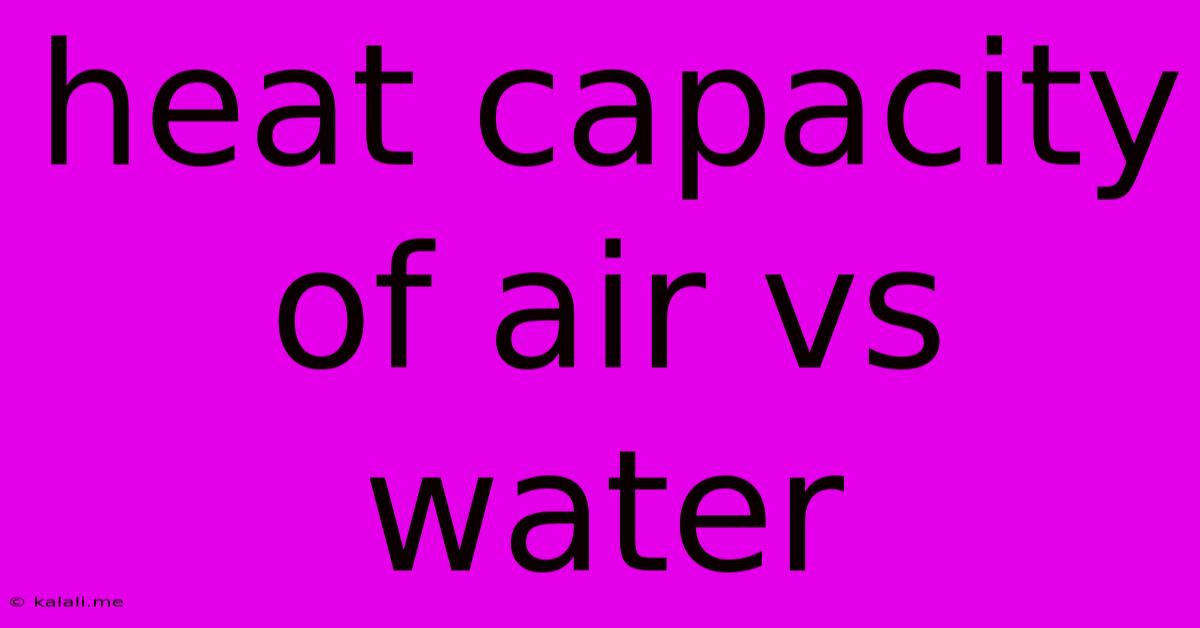Heat Capacity Of Air Vs Water
Kalali
May 31, 2025 · 3 min read

Table of Contents
Heat Capacity of Air vs. Water: A Deep Dive into Specific Heat
Understanding the difference in heat capacity between air and water is crucial in various fields, from meteorology and climate science to engineering and everyday life. This article will explore the specific heat capacities of air and water, explaining why they differ so significantly and the implications of this difference. We'll delve into the factors contributing to these differences and highlight real-world applications of this knowledge.
What is Specific Heat Capacity?
Specific heat capacity is the amount of heat energy required to raise the temperature of one kilogram of a substance by one degree Celsius (or one Kelvin). It's a fundamental property of matter that reflects how effectively a substance can absorb and store thermal energy. Substances with high specific heat capacities require a significant amount of energy to change their temperature, while those with low specific heat capacities change temperature more readily.
Air vs. Water: A Tale of Two Specific Heats
The specific heat capacity of air is approximately 1 kJ/kg·K (kilowatt-hours per kilogram Kelvin), while that of water is considerably higher, around 4.18 kJ/kg·K. This means it takes more than four times the amount of energy to raise the temperature of one kilogram of water by one degree Celsius compared to one kilogram of air.
Why the Huge Difference?
This stark contrast stems from the differences in the molecular structure and intermolecular forces of air and water.
-
Molecular Structure and Bonds: Water (H₂O) molecules are polar, meaning they have a slightly positive and a slightly negative end. This polarity leads to strong hydrogen bonds between water molecules, requiring significant energy to overcome these bonds and increase their kinetic energy (and thus temperature). Air, primarily composed of nitrogen (N₂) and oxygen (O₂), consists of nonpolar molecules with weaker intermolecular forces. Less energy is needed to increase the kinetic energy of these molecules.
-
Degrees of Freedom: Water molecules have more degrees of freedom (ways to store energy) than air molecules. They can translate, rotate, and vibrate, leading to a higher capacity for absorbing energy without a large temperature increase.
-
Density: While not directly related to specific heat, the higher density of water compared to air means a given volume of water contains more molecules, further contributing to its greater heat capacity.
Real-World Implications
The difference in specific heat capacity between air and water has profound impacts on various aspects of our world:
-
Climate Regulation: The high specific heat capacity of water moderates temperatures near large bodies of water. Oceans and lakes act as massive heat reservoirs, absorbing and releasing heat slowly, preventing drastic temperature fluctuations in coastal regions.
-
Weather Patterns: The contrasting heat capacities of land and water are key drivers of weather patterns, including sea breezes and monsoon seasons. Land heats and cools faster than water, creating pressure differences that lead to wind.
-
Cooling Systems: Water's high specific heat capacity makes it an ideal coolant in various applications, from car engines to industrial processes. It can absorb a large amount of heat before experiencing a significant temperature rise.
-
HVAC Systems: The specific heat of air is a critical factor in designing heating, ventilation, and air conditioning (HVAC) systems for buildings. Engineers must carefully calculate the amount of energy needed to heat or cool a given volume of air.
Beyond the Basics: Factors Affecting Specific Heat
While the specific heat values mentioned are approximate, several factors can influence the precise value:
- Temperature: Specific heat is not always constant and can vary slightly with temperature.
- Pressure: Changes in pressure can also affect the specific heat capacity of both air and water.
- Humidity: The presence of water vapor in air increases its specific heat capacity.
In conclusion, the significant difference in the specific heat capacities of air and water arises from fundamental differences in their molecular structures and intermolecular forces. Understanding this difference is vital for comprehending a wide range of phenomena, from climate dynamics to engineering design. This knowledge provides a foundational understanding of heat transfer and its implications in our world.
Latest Posts
Latest Posts
-
Can Dolls Come To Life And Kill
Jun 01, 2025
-
What To Use When Screw Does Not Tighten
Jun 01, 2025
-
Sed Expression 1 Char 1 Unknown Command
Jun 01, 2025
-
Other Users And Shared Mac Storage
Jun 01, 2025
-
How To Fix A Dented Wooden Door
Jun 01, 2025
Related Post
Thank you for visiting our website which covers about Heat Capacity Of Air Vs Water . We hope the information provided has been useful to you. Feel free to contact us if you have any questions or need further assistance. See you next time and don't miss to bookmark.